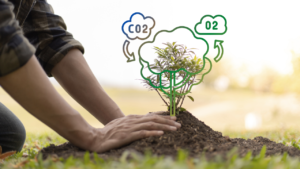Physical Address
23,24,25 & 26, 2nd Floor, Software Technology Park India, Opp: Garware Stadium,MIDC, Chikalthana, Aurangabad, Maharashtra – 431001 India
Physical Address
23,24,25 & 26, 2nd Floor, Software Technology Park India, Opp: Garware Stadium,MIDC, Chikalthana, Aurangabad, Maharashtra – 431001 India

CLAIM
Rise in CO2 levels is not harmful. Plants need CO2 to live.
FACT
CO2 itself is not a problem and is a part of the natural ecosystem but the problem is with the rising levels of CO2. Plants do need CO2 to live but rapid deforestation and rising CO2 levels is creating an imbalance with large amounts of residue CO2 in the atmosphere not being absorbed by plants, which is leading to global warming and climate change.
SOURCE OF THE CLAIM
We found a video on Facebook which had this claim, among a few others.
WHAT THEY SAY
Plants need carbon dioxide gas to live and so rising carbon dioxide levels can never be bad as it will help in nourishing more and more plants, including food crops at a faster rate. More food crops mean more food for the growing population of the world.
WHAT WE FOUND
Carbon dioxide (CO2) consists of one atom of carbon (C) and two atoms of oxygen (O). It is a clear gas, does not burn, and occurs naturally in small amounts (0.04 percent) in the atmosphere. It consists of a minor part of the air that humans breathe and is a byproduct of the human body’s metabolism.
THE NATURAL CYCLE
Carbon dioxide is essential to plant life. Plants absorb carbon dioxide from the atmosphere during photosynthesis, a process they use to make food. They break down the CO2 into carbon and oxygen and retain the carbon to live and grow while releasing the oxygen into the atmosphere. The carbon later regroups with the O2 in the air when the plant dies or is burned leading to the reformation of CO2, thus completing the cycle.
The more carbon dioxide they get to absorb, the less is the amount of carbon dioxide available in the atmosphere. This has been regarded as a boon for humankind at a time when rising levels of carbon dioxide in the atmosphere emitted as a result of anthropogenic activities, are a growing cause of concern in terms of global warming and climate change.
HUMAN-INDUCED RISE IN CO2
Human activities such as the burning of fossil fuels like coal, oil, and gas as well as rapid deforestation are the main causes of the drastic rise in the levels of carbon dioxide in the atmosphere. What is alarming is the fact that the annual peak of carbon dioxide in the atmosphere is now 50% higher than the industrial age levels. Also, the average rate of increase is the fastest at present.
Source: https://www.climate.gov
According to the National Oceanic and Atmospheric Administration, the average carbon dioxide level for May 2021 was 419.13 parts per million which are 1.82 parts per million higher than May 2020. This year (May 2022) the jump is slightly bigger, about 1.9 ppm more than the previous year pointing to the fact this is only getting worse with every passing year.
DECLINING CFE
Declining absorbing capacity is a growing cause of concern. Plants or to say in better terms, land ecosystems are increasingly becoming less efficient at absorbing carbon dioxide as levels of CO2 rise dramatically in the atmosphere. Scientists have concluded that about 86 percent of land ecosystems are losing their efficiency in terms of CO2 absorption quality.
CO2 is the primary ingredient needed by plants to grow. A higher concentration of CO2 leads to an increase in the photosynthesis process in plants causing an enhanced rate of growth which is known as the CO2 Fertilisation Effect or CFE. The CFE is the main factor to judge the response of the plant world to increasing CO2 levels in the atmosphere.
According to a study published in Science, “the global average CFE has decreased steadily since 1982 from 21 percent to 12 percent per 100 ppm of CO2 in the atmosphere”. Ben Poulter, study co-author and scientist at NASA’s Goddard Space Flight Centre noted, “In other words, terrestrial ecosystems are becoming less reliable as a temporary climate change mitigator.”
THE 1000 PPM THRESHOLD
Scientists have found that health problems can occur in humans after getting exposed to carbon dioxide at much lower levels than previously thought. The findings of a study published in the journal Nature Sustainability state that health problems can be caused by exposure to CO2 levels as low as 1000 per million (ppm) which is a far lower limit than the widely accepted 5000 ppm-level. What is alarming is the fact this threshold of 1000 ppm is already exceeded in many indoor environments like crowded rooms with poor ventilation systems. CO2 is a part of the natural global ecosystem and itself does not cause any problems. The problem is not with the naturally occurring CO2 but with the quantity of CO2 produced by humans which is increasing at an alarming level. Studies point out that there hasn’t been this level of CO2 in the atmosphere for 800,000 years.
Category: